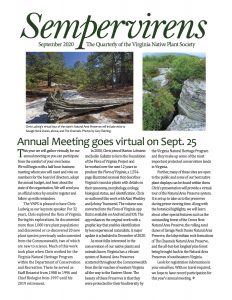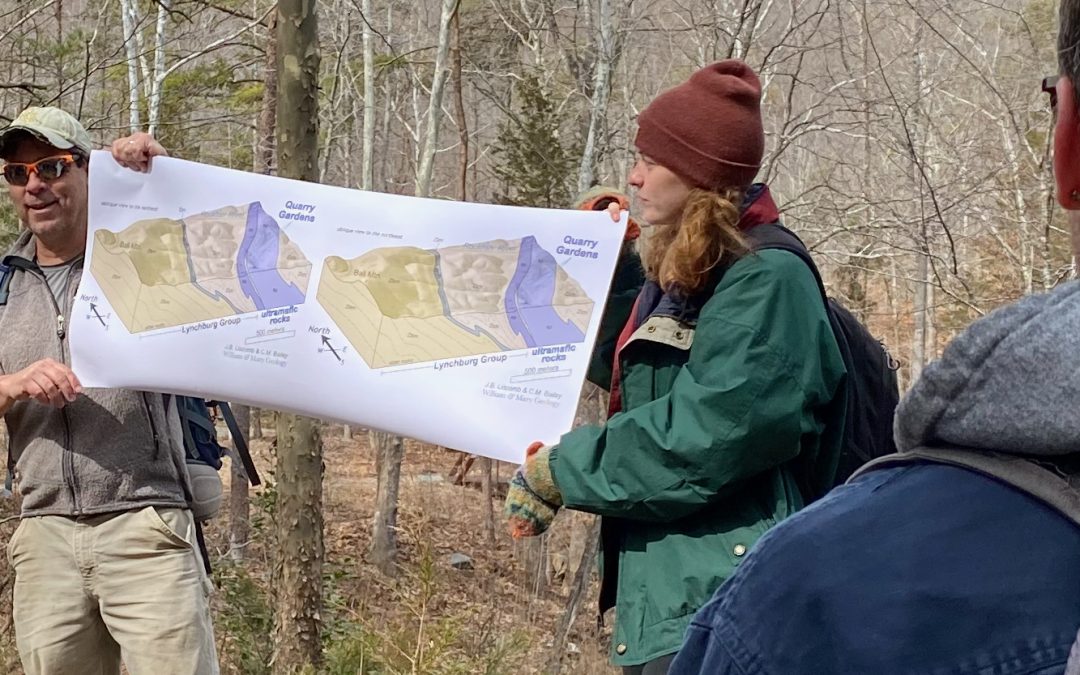
Mar 8, 2022
We greeted the year’s first group of visitors at the end of February when the Department of Geology at The College of William & Mary made a field trip to Schuyler locations of last summer’s 3D mapping project.
The tour was led by Department head Chuck Bailey and the “Schuyler Sisters,” graduate students who made up the research team.
One of the Sisters, Bel Liscom, is with Chuck in the featured photo.
Chuck will be back in September for a public presentation of the study and the geologic maps. At the same time, The Quarry Gardens will debut a new exhibit in the Visitor Center, product of a collaboration between the W&M geologists and Devin Floyd of the Center for Urban Habitats.
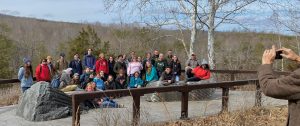
What would a field trip be without a group photo to record it?
The W&M project is being funded by a grant from the U.S. Geological Survey and by Polycor Corporation, owner of the Alberene Soapstone operation in Schuyler.
The Schuyler Sisters’ blog may be found at https://wmblogs.wm.edu/sgtresearch/we-are-the-schuyler-sisters/
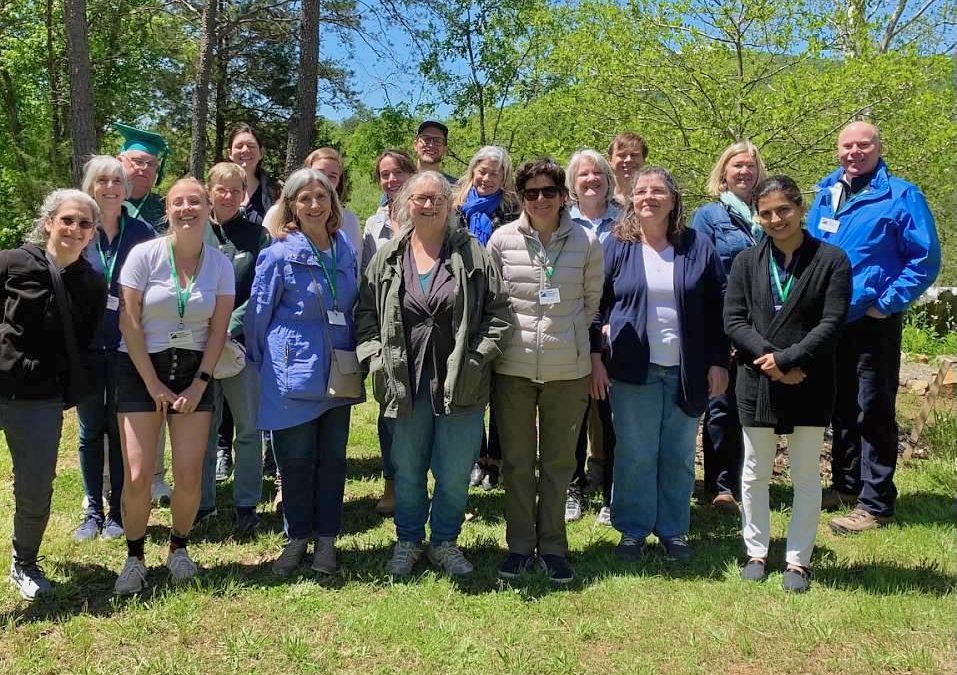
Jan 20, 2022
The featured image is of members of the Albemarle County Extension Master Gardeners’ 2021 training class who celebrated graduation with a field trip and picnic at the Quarry Gardens
All things considered, 2021 was a good year at the QGs. Here’s the summary:
Visitors: Although Covid-19 had most organized groups still postponing in-person meetings, we hosted 99 events and more than 1,000 visitors between April and November.
Helpers: Our wonderful volunteers contributed more than 300 hours assisting the Center for Urban Habitats team with planting and grooming native plants and managing invasive species. Besides working with Rachel Floyd on Friday mornings, several volunteers monitor and manage favorite areas of the Gardens independently. Julie Farrell contributed 69 hours; Martha Donnelly, Ron Fandetti, and Taylor Randolph each logged more than 30 hours. Volunteers came from Master Gardener and Master Naturalist units of Albemarle and Nelson counties. Their work complements our own and that of two paid staff.
Friends: We rolled over 2020’s memberships to 2021, but many generous Friends contributed anyway, and the roster of 64 grew to 71 supporting the Gardens with membership fees, gifts in kind, and volunteer service.
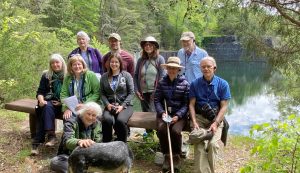
Virginia Native Plant Society President Nancy Vehrs brought members of her own Prince William Chapter to the Quarry Gardens in May. Skyla the dog photo-bombed.
Explorers: This new category of membership, which gives access to nearly 13 miles of trails through the remainder of the 600-acre property, has added 11 Explorer Friends who pay $200 per season or volunteer 40 hours. Explorers may visit most anytime, year around, and follow the trail map up the mountain and along the ledges above the Rockfish River. By request, qualified persons also may have access to the trails for research. Observations may be recorded at: https://www.inaturalist.org/projects/quarry-gardens-biodiversity
Publication: Seasons at the Quarry Gardens joined the shelf of books available for purchase in the Visitor Center. Its 48 pages lead readers on a photographic tour of the gardens through the four seasons. It also includes maps and descriptions of the natural communities and the planted galleries. Written, compiled, and designed by Bernice Thieblot with assistance from CUH’s Devin and Rachel Floyd, Seasons is also available by request via the website’s Contact.
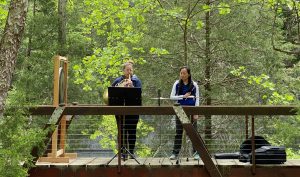
The North Quarry Bridge made a fitting stage for splendid performances by Katy Ambrose on horns, and percussionist I-Jen Fang.
Events:A highlight of the summer was Victory Hall Opera Company’s two sold-out performances of Soundflight, an immersive concert within the quarries’ natural amphitheater. A series of Soundflight 2 performances is planned for early June 2022.
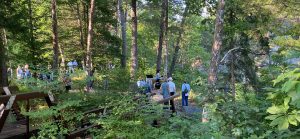
The audience for Soundflight followed the program by following the main trail.
Research: William & Mary professor of geology Chuck Bailey led a team of five graduate students on a study of the QGs and the Schuyler area during the hottest part of the summer. Their project, to create a 3D map of the underlying geology, funded by the U.S. Geological Survey, resulted in an impressive report that Chuck has offered to present at the QGs in the spring. The Blue Ridge Mycological Society continues to meet and foray here monthly, adding new fungi species to the QGs biota and sharing data with the North American Mycoflora Project. The native lawn study plots may yield findings in 2022; Ron Fandetti has helped CUH monitor and manage them.
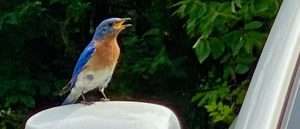
Bluebirds are social animals, except during nesting season when they will try to remove their own images from car mirrors.
Wildlife: A record 48 bluebirds fledged from the nine nest boxes at QGs and on the adjoining conservation site. Near the end of the season, we placed more boxes, bringing the total to 16. Master Naturalist Gareth Hunt, who volunteers for the Bluebird Society, monitors the boxes throughout the nesting season. For the second year, we had fox kits born in the boulder pile east of the picnic pavilion.
Plant sharing: We were pleased to again have a team from the non-profit Little Bluestem Nursery visit to gather seeds; unfortunately, so voracious were the deer this year that they had less to choose from than previously. The 2022 spring sale of the Jefferson Chapter of the Virginia Native Plant Society will include plants propagated by member Will Shaw from seeds collected at the Quarry Gardens.
Media: In April, Cville Weekly featured Rivanna Master Naturalists’ use of the QGs as a volunteer certification training site. The June issue of the Ecological Landscape Alliance newsletter featured an article by Cynthia Wood. Soundflight was covered by The Daily Progress and NPR. The summer issue of Smith Mountain Laker magazine featured a lengthy article by Catriona Erler. An article by Clover Carroll appeared in a September issue of The Crozet Gazette. In October, Charlottesville NPR affiliate WVTF featured a RadioIQ interview of the Thieblots by Sandy Hausman. These stories may be found linked to the blog archive at quarrygardensatschuyler.org.
Recognition: In December, we were delighted to receive an award for the QGs’ adaptive re-use from Preservation Piedmont in a ceremony at Ash Lawn.
In the coming year, we look forward to:
Having cell service: Armand’s long campaign succeeded. Verizon will start building on land adjacent to the QGs in January, aiming to complete the tower by March.
Seeing more flowers: The deer exclosure constructed to protect and show our most vulnerable plants was so successful at demonstrating the difference between deer and no deer that we have contracted to have more than a mile of 8-foot fencing constructed around the planted areas in time for spring opening.
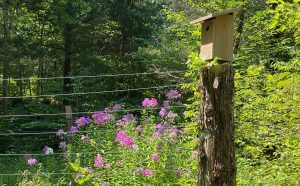
Native Summer phlox blooming within the deer exclosure convinced us to exclude deer from all the planted areas.
A new geology exhibit: Using data and images from the William & Mary project, we hope to develop a new permanent geology exhibit. A dendrology exhibit is also in the works.
A roster of talented guides: We are cultivating volunteers to lead special-interest tours for native plant enthusiasts, gardeners, birders, mycologists, herpetologists, odonata enthusiasts, artists, and photographers. Please let us know if you would like to join and guide.
Seeing many more visitors—as soon as possible. And finding more ways to realize the potential of this magnificent site.
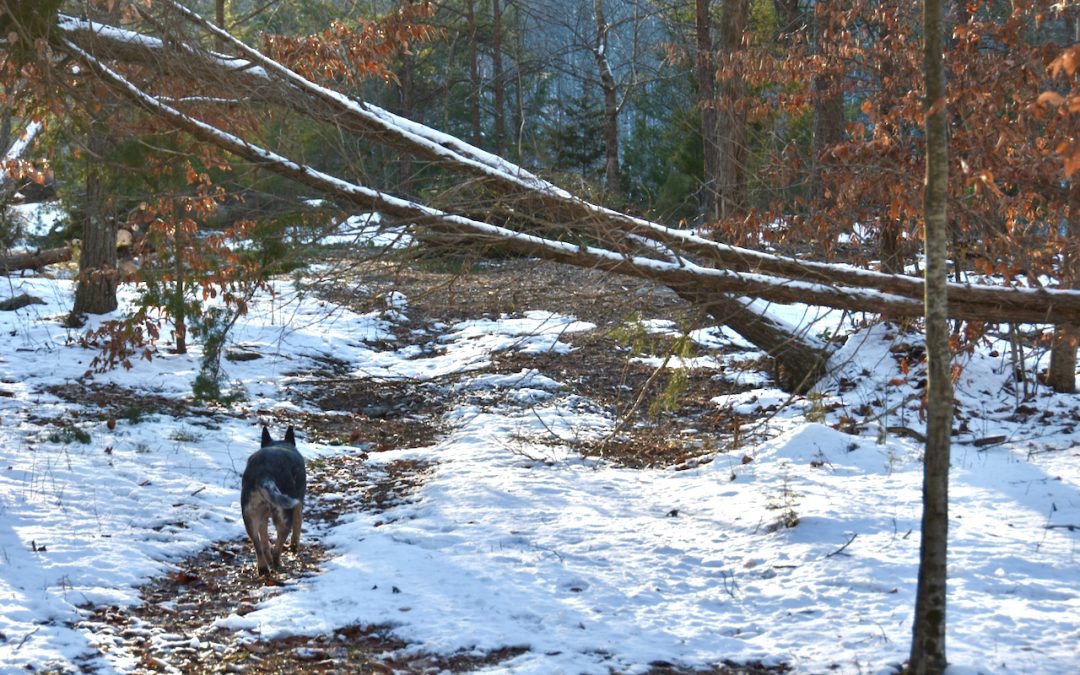
Jan 10, 2022
Hundreds of trees fell across roads and trails at the Quarry Gardens under the weight of January 3’s snowstorm. Mostly tall Virginia pines and Eastern red cedars, they brought with them countless smaller deciduous trees and shrubs. Fortunately, the visitor center, picnic pavilion, and bridges were spared. These photos were made after the roads were cleared.
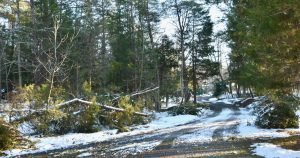
On the 9th, in a cold drizzle, members of the Blue Ridge Mycological Society joined Armand and QGs property manager Forrest Maguire to take on some of the tough jobs.
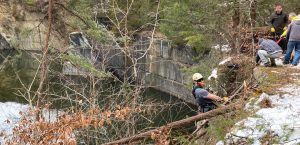
Several trees had fallen into the water, including a huge pine that now stands upside down near the center of the South Quarry. Convener of the BRMS Pat Mitchell rappelled down the side to release some pines that had toppled over the edge and hung up. Charlie Aller, Mike Nye, and Chuck Theisen pulled, cut, and stacked.
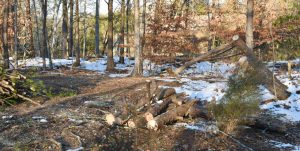
The Pine Needle Pathway that leads to the Quarry Overlook is now somewhat less piney, as several of the largest trees fell. In the background is the picnic pavilion.
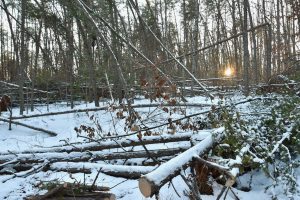
Uphill in the Preserve, what looks almost like a lumber yard in the background of this photo is a pile of trees as they fell—like pick-up sticks.
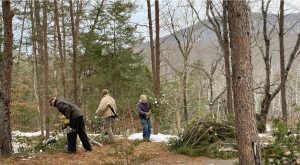
Much has been done to create access to the mess, but clean-up will take until the daffodils bloom. Anyone feeling the need for such exercise is earnestly invited to join the effort.
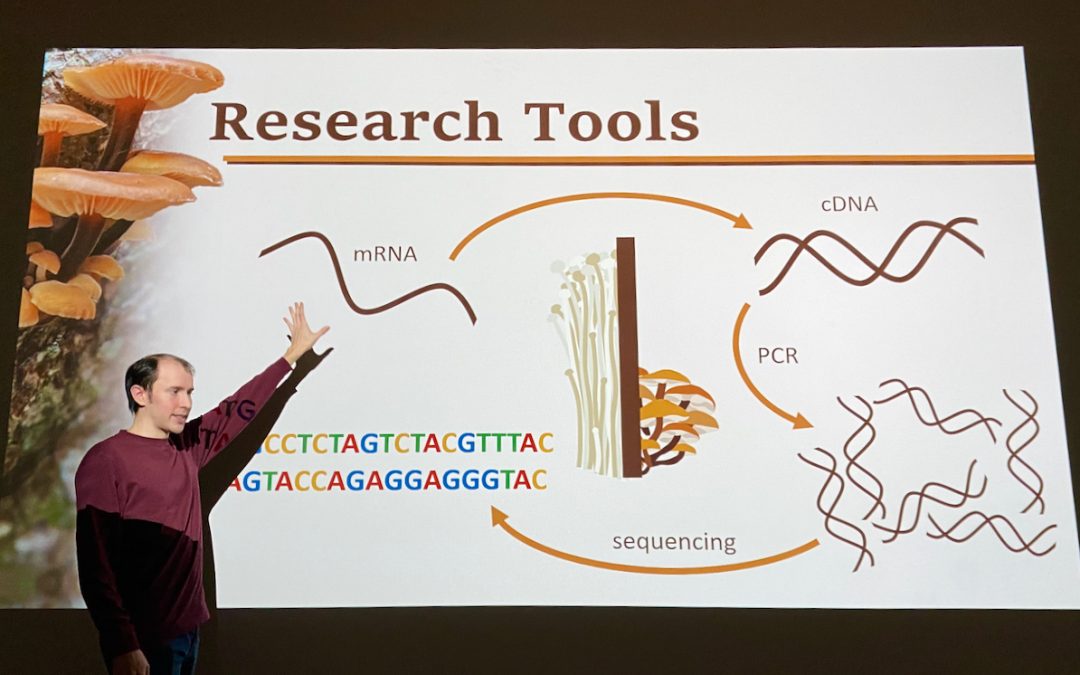
Dec 19, 2021
Did you know that the cultivated enoki mushrooms you find in the store’s produce section look completely different from wild enokis? Thomas Roehl wants to know why. He shared this question with us—along with the basics of mushroom development—in a talk sponsored by the Blue Ridge Mycological Society at the Quarry Gardens on the chilly morning of December 19.
A UVA graduate in biology, Thomas did his first mushroom hunting in southwestern Virginia. At the University of Wisconsin-Lacrosse, he has pursued the question of differences in gene expression of cultivated and wild enoki mushrooms (Flamulina velupides) as the basis of his Master’s thesis. Beginning in January, he will be continuing this work in a PhD program at Clark University in Massachusetts.
Following Thomas’s illuminating talk—which gave us new appreciation for the complexity of genetic research—we made a brief foray along the main QGs trail. Along the way, we encountered some common shelf mushrooms.
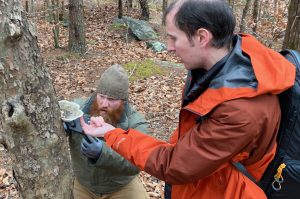
Where woodchips had fallen next to a cut tree, Pat Mitchell displayed a mycelial mat found by Sue Gaeta.
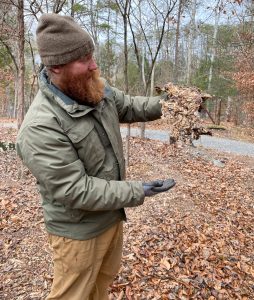
We discovered blue Turkey tails colonizing the seat of a bench near the small picnic grove.
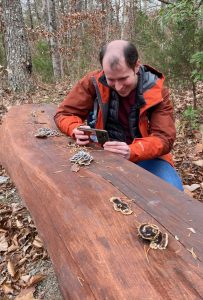
…and Thomas identified a Smoky-eyed boulder lichen (Porpidia albocaerulescens) that Pat enlarged with his camera lens to reveal its black-outlined apothecia.
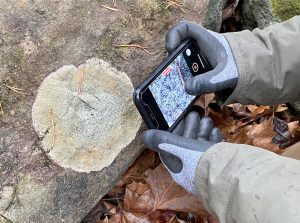
All of which is to say why we welcome researchers and scholars to the QGs. From them, we are constantly learning new things about this beautiful and fascinating place.
Because fungi are everywhere, affecting everything, study of them is a playground for the curious mind. Thomas reports on his journey in a wide-ranging and entertaining blog: fungusfactfriday.com
The Blue Ridge Mycological Society meets here monthly. To learn more, see https://www.facebook.com/groups/2130274707190367/about/
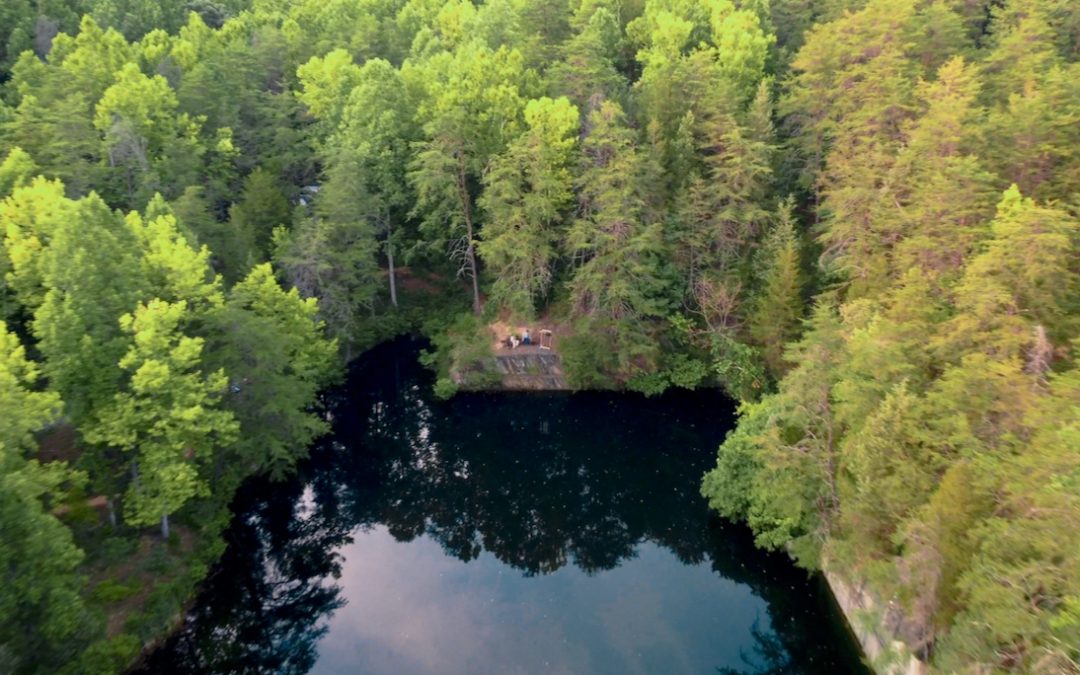
Sep 8, 2021
Those tiny performers in the photo made powerful sounds—thanks to their own talents, and to the amazing acoustical effects of the quarries’ massive stone walls and deep water.
Audiences for the Victory Hall Opera company’s Soundflight in late July walked the main trail to follow a program that staged performers around the perimeters of both quarry pools. The two performances sold out immediately and were so much fun that a multi-date repeat with a new program is being planned for 2022.
Watch this space—or https://www.victoryhallopera.org— for news.




















